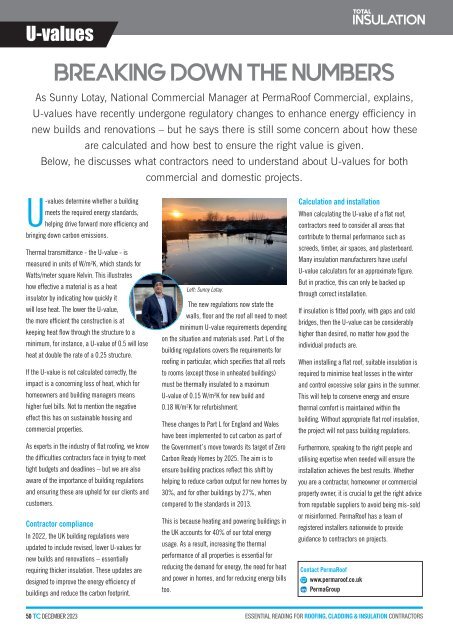December 2023
Create successful ePaper yourself
Turn your PDF publications into a flip-book with our unique Google optimized e-Paper software.
U-values<br />
BREAKING DOWN THE NUMBERS<br />
As Sunny Lotay, National Commercial Manager at PermaRoof Commercial, explains,<br />
U-values have recently undergone regulatory changes to enhance energy efficiency in<br />
new builds and renovations – but he says there is still some concern about how these<br />
are calculated and how best to ensure the right value is given.<br />
Below, he discusses what contractors need to understand about U-values for both<br />
commercial and domestic projects.<br />
U-values determine whether a building<br />
meets the required energy standards,<br />
helping drive forward more efficiency and<br />
bringing down carbon emissions.<br />
Thermal transmittance - the U-value - is<br />
measured in units of W/m²K, which stands for<br />
Watts/meter square Kelvin. This illustrates<br />
how effective a material is as a heat<br />
insulator by indicating how quickly it<br />
will lose heat. The lower the U-value,<br />
the more efficient the construction is at<br />
keeping heat flow through the structure to a<br />
minimum, for instance, a U-value of 0.5 will lose<br />
heat at double the rate of a 0.25 structure.<br />
If the U-value is not calculated correctly, the<br />
impact is a concerning loss of heat, which for<br />
homeowners and building managers means<br />
higher fuel bills. Not to mention the negative<br />
effect this has on sustainable housing and<br />
commercial properties.<br />
As experts in the industry of flat roofing, we know<br />
the difficulties contractors face in trying to meet<br />
tight budgets and deadlines – but we are also<br />
aware of the importance of building regulations<br />
and ensuring these are upheld for our clients and<br />
customers.<br />
Contractor compliance<br />
In 2022, the UK building regulations were<br />
updated to include revised, lower U-values for<br />
new builds and renovations – essentially<br />
requiring thicker insulation. These updates are<br />
designed to improve the energy efficiency of<br />
buildings and reduce the carbon footprint.<br />
Left: Sunny Lotay.<br />
The new regulations now state the<br />
walls, floor and the roof all need to meet<br />
minimum U-value requirements depending<br />
on the situation and materials used. Part L of the<br />
building regulations covers the requirements for<br />
roofing in particular, which specifies that all roofs<br />
to rooms (except those in unheated buildings)<br />
must be thermally insulated to a maximum<br />
U-value of 0.15 W/m²K for new build and<br />
0.18 W/m²K for refurbishment.<br />
These changes to Part L for England and Wales<br />
have been implemented to cut carbon as part of<br />
the Government’s move towards its target of Zero<br />
Carbon Ready Homes by 2025. The aim is to<br />
ensure building practices reflect this shift by<br />
helping to reduce carbon output for new homes by<br />
30%, and for other buildings by 27%, when<br />
compared to the standards in 2013.<br />
This is because heating and powering buildings in<br />
the UK accounts for 40% of our total energy<br />
usage. As a result, increasing the thermal<br />
performance of all properties is essential for<br />
reducing the demand for energy, the need for heat<br />
and power in homes, and for reducing energy bills<br />
too.<br />
Calculation and installation<br />
When calculating the U-value of a flat roof,<br />
contractors need to consider all areas that<br />
contribute to thermal performance such as<br />
screeds, timber, air spaces, and plasterboard.<br />
Many insulation manufacturers have useful<br />
U-value calculators for an approximate figure.<br />
But in practice, this can only be backed up<br />
through correct installation.<br />
If insulation is fitted poorly, with gaps and cold<br />
bridges, then the U-value can be considerably<br />
higher than desired, no matter how good the<br />
individual products are.<br />
When installing a flat roof, suitable insulation is<br />
required to minimise heat losses in the winter<br />
and control excessive solar gains in the summer.<br />
This will help to conserve energy and ensure<br />
thermal comfort is maintained within the<br />
building. Without appropriate flat roof insulation,<br />
the project will not pass building regulations.<br />
Furthermore, speaking to the right people and<br />
utilising expertise when needed will ensure the<br />
installation achieves the best results. Whether<br />
you are a contractor, homeowner or commercial<br />
property owner, it is crucial to get the right advice<br />
from reputable suppliers to avoid being mis-sold<br />
or misinformed. PermaRoof has a team of<br />
registered installers nationwide to provide<br />
guidance to contractors on projects.<br />
Contact PermaRoof<br />
www.permaroof.co.uk<br />
PermaGroup<br />
50 TC DECEMBER <strong>2023</strong>

















